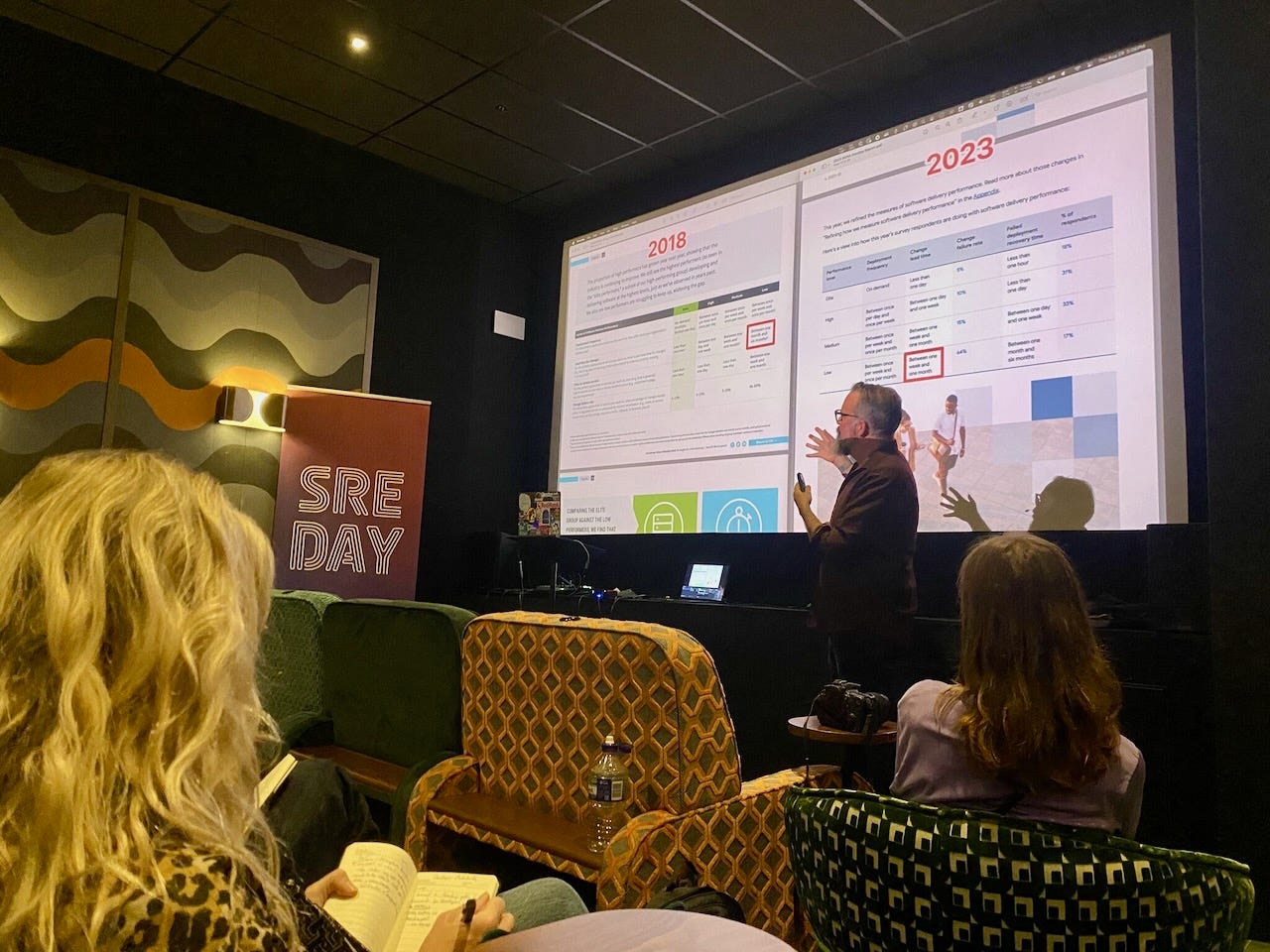Coté
Oscar Health’s early observations on OpenAI o1-preview - Experiments with using AI in healthcare, specially the chain of reasoning stuff in o1-preview.
To Improve Your Mean Time to Recovery, Start at the Beginning - How to think about securing your cloud native apps, and apps in general.
The impact of AI on the workforce: Tasks versus jobs? - “While many businesses use AI to replace worker tasks, there is little evidence that AI use is associated with a decline in firm employment.” // I’m starting to think that what’s going on here is that we haven’t found the right applications (uses of) for generative AI. Keep exploring!
Did a digital obsession ‘Just Do It’ in for Nike’s John Donahoe? - Getting direct versus channel (partners, “middlemen”) right is difficult. It’s especially risky when you dramatically change it (move from selling direct to selling through middle-people, or the other way around).
The Camera is the Filter - “Digital cameras are, themselves, a filter—each one reflects the technology and aesthetics of its time. A photo taken on an early 2000s digital camera, for instance, captures not only the subject but also the era’s unique imperfections—grainy textures, soft focus, lower resolutions, and muted colors. These qualities are part of the photo’s authenticity, a snapshot of history shaped by the camera’s limitations. Adding filters that emulate an old type of film erases that context, replacing the original look with a trendy (at the time), artificial aesthetic that distorts the photograph’s integrity. To me, that defied what I thought the purpose of the job was, which was to document these factories in that particular moment in time."
Six technology myths and the Big Tech-lash - “So why do people think that it’s getting faster? Well, one of the reasons is they sort of conflate applications with platforms. So sure, ChatGPT gets 100 million people in a couple of months. But why is that? Well, they didn’t have to buy anything. I didn’t have to install anything. I could just go use it. And to me, that’s no different than saying that the Milton Berle show on TV went from no users to 50 million users in a year because all you had to do was turn on the station. And so the applications, whether it’s Facebook or Google or ChatGPT, it’s much easier to put an application on top of a radio program, a television or a computer or the internet than to buy a new platform.” And: “Data isn’t [the] new oil. I wish it were true. If only the world revolved around computers and data and information and connectivity and networks, life would be better. But the reality is that energy is still the main force in the global economy."
Employee Mode
You are a company of one: Click here to watch the video.
If you liked that, there’s more of my take on “employee mode” in the ten part video series I did for O’Reilly: “How to Survive and Thrive in a Big Company: Tactics and Practices to Manage Your Time and Relationships.” How about that title, huh?!
If you work at a large company, you might even have access. Or, just get 10 days free.
Anyhow: watch the videos, and if you like them, leave a cool review. HEY GUYSZ!1!!
Wastebook
We’ve got to stop using the “is dead” thing. It’s hardly ever accurate and mostly a cheap trick. (It works in zero-sum marketing and community management sometimes, though: 10% to 20% of the time?)
“Autocado.”
‘(In his essay, Parini recounts an old story about the literary critic, Harold Bloom. Bloom was famously prolific, and the story goes that a graduate student once phoned Bloom and his wife answered and said: “I’m sorry, he can’t talk–he’s writing a book.” The student responded: “That’s all right. I’ll wait.”)’ Here.
‘The term “pseudoclarity” refers to a misleading sense of clarity that arises from overly simplistic metrics and frameworks, like those often used in Scrum methodologies. It highlights the danger of relying on superficial calculations and symbols that may obscure the true complexity and uncertainty of real-world projects, leading to a false sense of control and understanding.’ From “Tossed Salads And Scrumbled Eggs,” as understood by Perplexity.ai. Related:
It’s better to reverse engineer the strategy from how it gets implemented than pay much attention to the annual planning PowerPoint.
Or: strategy is defined execution, not PowerPoint.
“‘Deep doubt’ is skepticism of real media that stems from the existence of generative AI.” Benj Edwards.
I wouldn’t say they lied. More so that they did a bad job predicting.
“Rye is Canadian, right?” “You better find out.” Mad Men.
And: “I’m living like there’s no tomorrow, because there isn’t one.” “I don’t think I realized until this moment: but, it must be hard being a man, too.” Ibid.
Living the memento mori corporate life.

Relative to your interests
IDC #US52372824 (June 2024). Source: IDC DevOps Survey, - “79.1% of respondents are extending, using, or piloting Wardley Mapping to diagram the value chain and application components, demonstrating the value it can add to strategic application planning.” IDC #US52372824 (June 2024). Source: IDC DevOps Survey, November 2023, n = 311. // I never would have guessed that, but people do talk about those maps a lot.
Digital transformation strategies focus on reducing costs, upskilling - Highlights from Macroeconomic Outlook, Business Trends - ”Digital transformation focuses on employee productivity and automation. Nearly 44% of respondents either have a formal digital transformation strategy (32%) or are planning to develop one (11%). The primary drivers for adopting a digital transformation strategy are improving efficiency through process automation (59%), improving employee productivity (56%) and customer experience enhancements (47%). The main priorities in digital transformation are to improve workforce productivity and engagement experiences (44%), followed by intelligent automation to reduce/remove need for labor and manual processes (43%). Modernizing legacy back-office (e.g., ERP, supply chain) and front-office (e.g., customer relationship management, e-commerce) applications is also a top priority in digital transformation.”
Free ‘JavaScript’ from Legal Clutches of Oracle, Devs Petition - This seems like a don’t wake the sleeping bear situation.
The types information available on the internet and why AI is bad for all of them - ”For example, if I’m looking to buy an ergonomic chair and I read a review that says “I’m a 6’3” man and this chair is absolutely perfect for my size,” this anecdote provides helpful information to me in a way that simply reading the measurements does not.”
AI is great for churning out apps, but don’t forget to test - Enterprise AI needs testing just like code needs testing. // “Research published by Leapwork, drawn from the feedback of 401 respondents across the US and UK, noted that while 85 percent had integrated AI apps into their tech stacks, 68 percent had experienced performance, accuracy, and reliability issues.”
Customers don’t trust AI, and the rift might be hurting business - ”Participants were then asked questions to determine their willingness to buy the TV. Those who saw AI in the product description were less likely to make the purchase.”
CIOs: Get Tech Sprawl Under Control - “According to Forrester’s Q2 2024 Tech Pulse Survey, a staggering 77% of US technology decision-makers report moderate to extensive levels of technology sprawl. This sprawl can result in unsustainable costs, slower IT delivery, reduced operational resilience, and increased security risks.”
Business leaders are losing faith in IT, according to this IBM study. Here’s why - “Fewer than half (47%) of business leaders surveyed think their IT organization is “effective in basic services,” down from 69% surveyed in 2013, the survey shows. Only 36% of CEOs in the survey see IT as effective, down from 64% since 2013. Chief financial officers give a bit more credit to IT, with 50% seeing its effectiveness, but this is down from 60% since 2013.”
IBM buys Kubernetes cost control startup Kubecost to expand its FinOps suite - They’ve bought a lot in this category - solution suite’ing. ”IBM said Kubecost’s capabilities will be integrated into an expanding FinOps Suite, enhancing the combined capabilities of Apptio, Cloudability, Instana and Turbonomic to provide what will perhaps be the most comprehensive cost monitoring toolset around. The company didn’t say so, but there is clear potential for Kubecost’s technology to be integrated with IBM’s OpenShift application development platform too.”
How PepsiCo capped cloud overspend - ‘“FinOps is all about evangelization,” Woo said. “This is probably the most difficult side of running a FinOps practice, because when you are a FinOps practitioner you’re trained to do IT work. You may have had a finance background. You weren’t trained to be a mediator or therapist.”’
Conferences
Talks I’m giving, places I’ll be, and other plans.
Cloud Foundry Day EU, Karlsruhe, Oct 9th. VMware Explore Barcelona, speaking, Nov 4th to 7th. GoTech World, speaking, Bucharest, Nov 12th and 13th. SREday Amsterdam, speaking, Nov 21st, 2024.
Discounts! SREDay Amsterdam: 20% off with the code SRE20DAY. Cloud Foundry Day 20% off with the code CFEU24VMW20.
Logoff

// I’m pretty sure it was Brandon who came up with the phrase “employee mode,” just in the off-handed way that you do in a podcast. It’s great, right?
// Thanks for subscribing! I think we’re on track to 1,000 subscribers sometime over the next two months. That’ll be thrilling! You know: tell a friend, recommend it, etc. IT MAKES ME HAPPY.
See you next episode.
Digital transformation strategies focus on reducing costs, upskilling - Highlights from Macroeconomic Outlook, Business Trends - ”Digital transformation focuses on employee productivity and automation. Nearly 44% of respondents either have a formal digital transformation strategy (32%) or are planning to develop one (11%). The primary drivers for adopting a digital transformation strategy are improving efficiency through process automation (59%), improving employee productivity (56%) and customer experience enhancements (47%). The main priorities in digital transformation are to improve workforce productivity and engagement experiences (44%), followed by intelligent automation to reduce/remove need for labor and manual processes (43%). Modernizing legacy back-office (e.g., ERP, supply chain) and front-office (e.g., customer relationship management, e-commerce) applications is also a top priority in digital transformation.”
Free ‘JavaScript’ from Legal Clutches of Oracle, Devs Petition - This seems like a don’t wake the sleeping bear situation.
The types information available on the internet and why AI is bad for all of them - ”For example, if I’m looking to buy an ergonomic chair and I read a review that says “I’m a 6’3” man and this chair is absolutely perfect for my size,” this anecdote provides helpful information to me in a way that simply reading the measurements does not.”